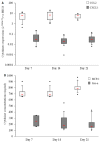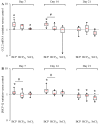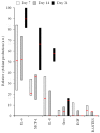Strontium-Substituted Bioceramics Particles: A New Way to Modulate MCP-1 and Gro-α Production by Human Primary Osteoblastic Cells
- PMID: 28774105
- PMCID: PMC5456992
- DOI: 10.3390/ma9120985
Strontium-Substituted Bioceramics Particles: A New Way to Modulate MCP-1 and Gro-α Production by Human Primary Osteoblastic Cells
Abstract
Background: To avoid morbidity and limited availability associated with autografts, synthetic calcium phosphate (CaP) ceramics were extensively developed and used as bone filling materials. Controlling their induced-inflammatory response nevertheless remained a major concern. Strontium-containing CaP ceramics were recently demonstrated for impacting cytokines' secretion pattern of human primary monocytes. The present study focuses on the ability of strontium-containing CaP to control the human primary bone cell production of two major inflammatory and pro-osteoclastogenic mediators, namely MCP-1 and Gro-α, in response to ceramics particles.
Methods: This in vitro study was performed using human primary osteoblasts in which their response to ceramics was evaluated by PCR arrays, antibody arrays were used for screening and real-time PCR and ELISA for more focused analyses.
Results: Study of mRNA and protein expression highlights that human primary bone cells are able to produce these inflammatory mediators and reveal that the adjunction of CaP in the culture medium leads to their enhanced production. Importantly, the current work determines the down-regulating effect of strontium-substituted CaP on MCP-1 and Gro-α production.
Conclusion: Our findings point out a new capability of strontium to modulate human primary bone cells' communication with the immune system.
Keywords: calcium-phosphate; cytokines; human primary bone cells; strontium.
Conflict of interest statement
The authors declare no conflict of interest.
Figures




Similar articles
-
Effect of strontium-substituted biphasic calcium phosphate on inflammatory mediators production by human monocytes.Acta Biomater. 2012 Aug;8(8):3113-9. doi: 10.1016/j.actbio.2012.04.045. Epub 2012 May 8. Acta Biomater. 2012. PMID: 22579711
-
Influence of strontium on the synthesis and surface properties of biphasic calcium phosphate (BCP) bioceramics.J Appl Biomater Biomech. 2010 Sep-Dec;8(3):153-8. J Appl Biomater Biomech. 2010. PMID: 21337306
-
Human mesenchymal stem cells response to multi-doped silicon-strontium calcium phosphate coatings.J Biomater Appl. 2014 May;28(9):1397-407. doi: 10.1177/0885328213510056. Epub 2013 Oct 25. J Biomater Appl. 2014. PMID: 24163332
-
Bioactive behavior of silicon substituted calcium phosphate based bioceramics for bone regeneration.Mater Sci Eng C Mater Biol Appl. 2014 Feb 1;35:245-52. doi: 10.1016/j.msec.2013.11.013. Epub 2013 Nov 18. Mater Sci Eng C Mater Biol Appl. 2014. PMID: 24411375 Review.
-
Strontium ranelate in osteoporosis.Curr Pharm Des. 2002;8(21):1907-16. doi: 10.2174/1381612023393639. Curr Pharm Des. 2002. PMID: 12171530 Review.
Cited by
-
Building Osteogenic Microenvironments With Strontium-Substituted Calcium Phosphate Ceramics.Front Bioeng Biotechnol. 2020 Oct 7;8:591467. doi: 10.3389/fbioe.2020.591467. eCollection 2020. Front Bioeng Biotechnol. 2020. PMID: 33117789 Free PMC article. Review.
-
Inflammatory Response of Human Peripheral Blood Mononuclear Cells and Osteoblasts Incubated With Metallic and Ceramic Submicron Particles.Front Immunol. 2018 Apr 25;9:831. doi: 10.3389/fimmu.2018.00831. eCollection 2018. Front Immunol. 2018. PMID: 29922277 Free PMC article.
-
Octacalcium Phosphate for Bone Tissue Engineering: Synthesis, Modification, and In Vitro Biocompatibility Assessment.Int J Mol Sci. 2021 Nov 25;22(23):12747. doi: 10.3390/ijms222312747. Int J Mol Sci. 2021. PMID: 34884557 Free PMC article.
References
LinkOut - more resources
Full Text Sources
Other Literature Sources
Miscellaneous

